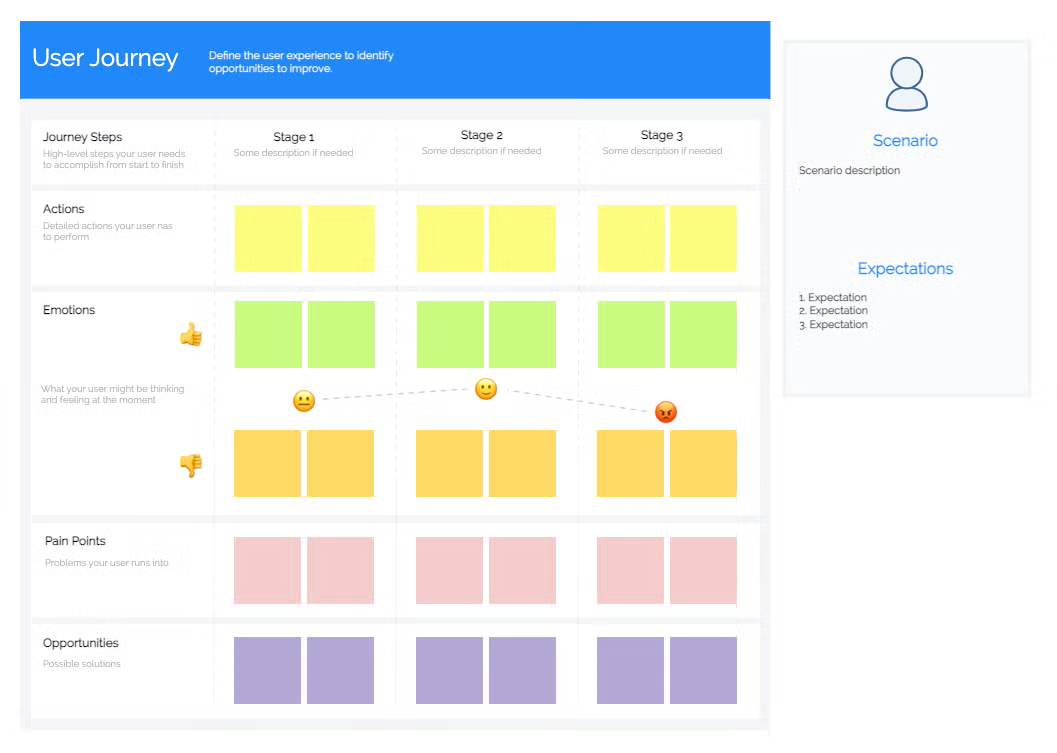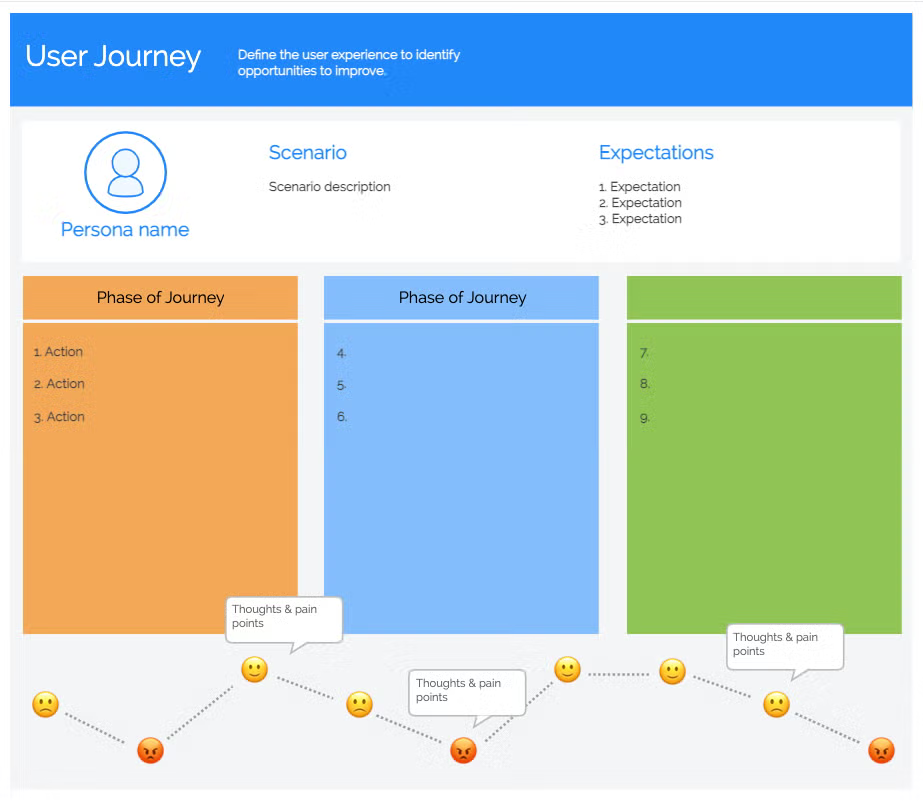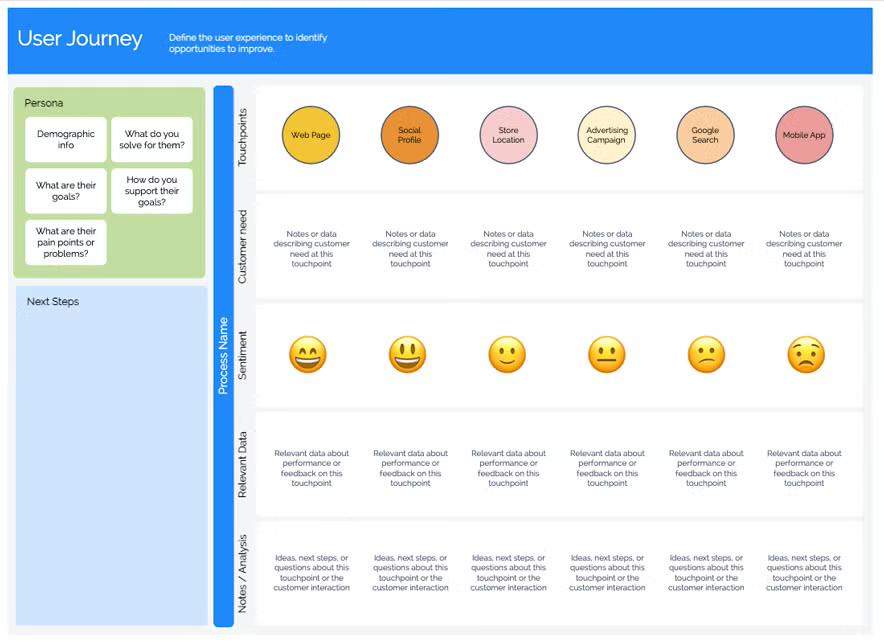What is Journey Mapping?
Customer journey mapping or user journey mapping is used to visualize your customers’ or users’ interactions with your brand. The journey mapping process allows businesses to better understand the customer experience, process data, and ultimately improve their interactions with customers.
Ready to make your own in Gliffy’s drag-and-drop diagramming tool for Confluence? You can get started with a free trial today!
Read on to learn more about how journey mapping works or jump ahead to one of the following sections to get started right away:
Why You Should Make a Customer Journey Map
There are three great reasons to make a customer journey map:
1. Build Empathy for Your Customer or User
By considering each interaction or step that your customer takes while buying from or working with your business, you can build empathy that helps you make better business decisions.
2. Put Analytics and Data in Context
Say your site analytics show that a certain page has a high bounce rate. A journey map will help pinpoint exactly where in the user journey you’re seeing a drop-off. Putting this data in context can help you improve the touchpoint or interaction — your current content may not be meeting the user’s needs at that point in their journey. With a journey map, you’re set up to problem-solve.
3. Optimize Your User Experience
By visualizing the common journeys and paths of your buyers or your “best” users, you can find the pieces of content and touchpoints that are making the biggest impact. With these, you can design efficient experiences that get higher conversion rates in fewer steps. From there, you can guide users to these high-performing experiences throughout your website, documentation, and communications.
Overall, journey mapping is a great way to make sure that your user experience meets the needs of your customer, along with other UX practices like user story mapping, empathy mapping, and wireframing.
What’s Included in Journey Maps
At its core, journey mapping creates a timeline with a little research and data added in. The types of additional information you’ll include will depend on the problem you’re trying to solve or the customer you’re investigating. Some common information to include is:
- Touchpoints: the relevant ways that your user interacts with your business or brand. This can include things like advertising, social media, your website, shopping in store, or talking to a sales representative.
- Attitudes or mindsets: what is your customer thinking at the time of this interaction? What does your customer need?
- Data about that touchpoint: relevant feedback from your users or analytics tools. This data could include website analytics like bounce rates or conversion rates, feedback like reviews following interactions with customer service teams, or notes from qualitative research like UX interviews.
How to Make a Customer Journey Map
There are obvious benefits to creating a customer journey map, but working with too many touchpoints or data inputs can get overwhelming. Here’s how to get specific and create a journey map that helps your team learn and problem-solve.
1. Identify the Problem, Challenge, or Scenario
Journey mapping should fit a specific process or outcome within your company. This could be a scenario that you want to optimize, a process that’s not working well for your users or customers, or a new scenario that you need to consider.
For example, you could create a map of the journey of a customer returning a purchase. This could be a new process that you’re testing, an established process that you’d like to optimize, or a process that you’ve received some negative feedback or results on.
2. Build the Customer Persona or Story
Journey maps should never be generic or fit all possible users or customers. Instead, you should be specific about who your customer or user is and create a few statements about the target persona. These statements will help your team build empathy, identify new or specific problems in their current experience, and find solutions that work best for your most important customers.
To use the example of a customer returning a purchase, your target customers may be busy moms. She wants to return an item she bought online and had shipped to her, but as a busy mom, driving to the nearest store and waiting in line to return the item could be a very challenging, negative experience.
By contrast, if your team had not identified a specific persona, returning an item at the store may not sound like a pain point or a negative experience at all. This is why it’s important to be specific about who your persona is and consider their wants and needs throughout the journey mapping process.
Here are some helpful questions to ask and research to develop your customer persona:
- What does your brand or product do for this customer?
- What problem is your customer experiencing?
- What are the goals of your customer?
- How does your product or brand support these goals?
For busy moms, your brand may be providing safe, high-quality products for their newborn. While shopping, these moms may say they feel overwhelmed by options and want an easy shopping experience that they can trust. Their ultimate goal — with or without your brand — is to create a safe, nurturing home for their baby. And last, your brand can support that goal by creating a convenient shopping experience that educates them on the safety and quality of your products.
To come up with more questions like these that are specific to your users, you might consider gathering your team for a brainstorming session where you'll use the starbursting method. This exercise will help you identify the most important questions you'll need to answer together to better understand your users.
3. Map Touchpoints or Interactions with Your Brand
With a backstory ascribed to your customer or user, map their interactions with your brand in chronological order. Remember to consider multiple channels and layer in any relevant data for your persona.
For example, you may know that word of mouth and recommendations play a large role in your brand’s growth among the “busy mom” persona. As you map the first touchpoint with your brand, like a google search, it can be helpful to layer in the data point that supports your understanding of the role of referrals and recommendations on your business.
After googling your brand and landing on your homepage, where does your persona usually go? They may browse product pages, read reviews, or visit one of your stores in person. At your store, do they talk to a sales associate, or is shopping hands-off? Each of these interactions is a valuable touchpoint.
To make sure you consider all the possible touchpoints or places where customers could be interacting with your brand. It can be helpful to make a mind map or a concept map to track interactions and places where your brand may show up for users. This would include things like social media platforms, marketing campaign tactics, elements of the in-store or online experience like sales chats, or customer support resources.
4. Add Customer or User Sentiment
With an overview of the touchpoints of your user journey, add any information or data you have on what the customer is thinking or feeling at the time of that interaction. This layer of your customer journey map can help you understand where a particular touchpoint is not meeting the customer’s needs or where you could build in additional support for your customer or user’s experience.
Because you’ve done your research and learned that many members of your “busy mom” persona feel overwhelmed by all the options available, look for places where your brand experience may be contributing to that same overwhelmed feeling. Within your quantitative data, “overwhelmed” could look like high bounce rates or exit rates on a web page, multiple conversations with sales associates, or purchasing and returning multiple products.
Then, do the opposite — where is your brand experience making it easy for them to make choices and giving them a sense of relief? Indicators of a positive experience could be high conversion rates on web pages or emails, positive reviews, and high rates of returning customers.
5. Analyze Your Journey Map for Opportunities to Improve
Now that you’ve finished journey mapping the current state of your customer journey and layered in any relevant data or feedback, you have a functional representation of the process that can guide your team to improve.
Look for anywhere in the journey where the touchpoint doesn’t meet the customer’s needs. Consider the timing and messaging of these touchpoints — are you giving the customer the right amount of information, but too soon in their buying process? Or, is the customer looking for more details and information when they walk into your store?
By analyzing the user or customer’s flow through these touchpoints, you can identify places where you could improve their experience.
Back to topStart with a Free Customer Journey Mapping Template
You can use Gliffy’s template to complete the five steps outlined above. Great templates have space to identify your target persona, pinpoint the problem you want to solve or the process you want to analyze, swimlanes or sections for the data and customer sentiment at each touchpoint, and space to add notes as you work with your team.
Once you've selected a template, just click and drag to move shapes, double-click to edit text, and drag and drop additional shapes from the side panel to build out your map. Check the layers panel to make sure the content you want to edit is "unlocked" if you're changing the template structure, too.
3-Stage User Journey Mapping Template

Phased User Journey Template

Process Journey Mapping Template

Back to top
Tips for Journey Mapping in Gliffy
Gliffy is an intuitive, drag-and-drop diagramming tool, so making a customer journey map in Gliffy takes just a few clicks. But, here are a few tips and tutorials to take your mapping exercise to the next level:
- ▶️ Video: Use layers in Gliffy to lock in the base or framework of your map
- ▶️ Video: Create a mind map or concept map to show and organize all the possible touchpoints for your users
- ✏️ Blog: Make a Swimlane Diagram to organize data and inputs along your customer’s journey
- ⚙️ Resource: Embed Gliffy Diagrams in other tools so your team can reference them later and provide feedback
Try Gliffy's Easy-to-Use Journey Mapping Software
Mapping exercises and templates like these will help your team build empathy for customers or users and effectively solve problems or improve their experience. To help visualize customer journeys and share them with your team, be sure to try Gliffy free for 30 days!